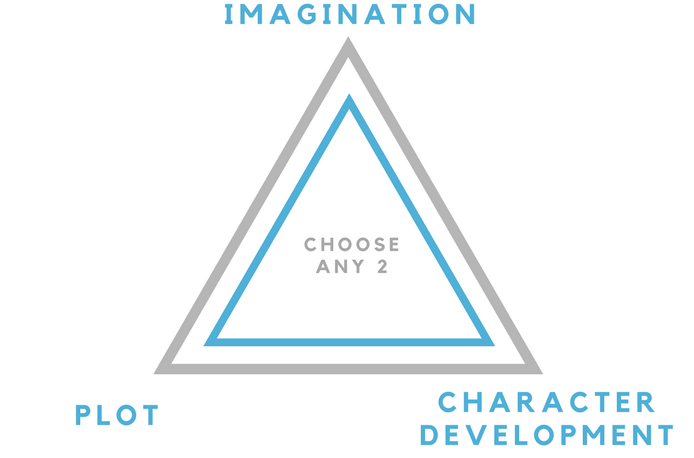
We all know when we’re watching a good movie, or reading a good book. There’s a captivation, a deep-seated enjoyment that hooks us and holds us tight until the very end. Then we sit back, grinning in awe and euphoria, and say, “Damn. That was fantastic.” But what causes these feelings? What makes a work of fiction good?
There are loads and loads of theories, formulae, and analyses that try to answer this question. Most are too abstract and self-righteously profound to be of any practical use. Over the years, however, I’ve come up with my own theories, which I’ve now attempted to condense into a relatively simple graphic model. I call it the Trinity of Narrative Fiction, and as the name implies, it’s relevant to stories in all media. My theory holds that there are three keys to the success and quality of any fictional narrative: plot, imagination, and character development. The best stories must excel at two of these—any two, and only two.

A story that follows the pattern of imagination + character development (ICD) is a seminal work—a genre-defining piece of fiction that builds an archetype. Typically, it creates unique worlds and characters, but relies on a simple and classically designed plot.
Lord of the Rings, at the time of its publication, was fiercely imaginative. Its central characters, especially Gandalf, Aragorn, and Frodo, were also colorful and memorable. Yet the story itself is familiar. Beyond the concept of the Ring itself, Tolkein’s saga describes a rote triumph of good over evil.
Consider also Harry Potter. The marriage of a magical setting to a boarding-school drama is surely unique, and the character development of Harry, Ron, Hermione, Snape, and Dumbledore is perhaps the most captivating piece of Rowling’s puzzle. However, the plots are far less special, and often reliant on deus ex machina—more often than not, there’s a convenient magical solution for each magical problem.

Imagination + plot (IP) is substantially less common, and narratives in this category usually fall short of the influence of ICD simply because an audience tends to remember characters better than plots. The deep rhythmic breathing, cryptic black armor, and conflicted morality of Darth Vader are embedded in our culture forever, but do you really remember everything that happened in The Shawshank Redemption? Chances are, the fragments that you do remember are character moments—Andy Dufresne blasting opera through the prison’s PA, or raising his hands to a stormy sky after crawling to freedom through a sewage pipe.
Still, IP contains some wonderful stories. Blade Runner pairs an enthralling high-tech setting with a convoluted and lore-heavy plot, even if Rick Deckard, Roy Batty, and Rachael are barely developed at all. Inception is also deeply inventive and heavy on plot, yet it’s populated with mostly forgettable characters.

Imagination requires novelty, which is both artistically difficult and commercially risky. Perhaps this is why the category that excludes imagination altogether—plot + character development (PCD)—is the most common. PCD includes all sequels, remakes, and derivative works, which follow safely in the footsteps of their more innovative IP and especially ICD ancestors. Game of Thrones, for example, apes the J.R.R. Tolkein medieval high-fantasy archetype. It’s not terribly imaginative, but George R.R. Martin relies instead on his excellent cast of characters and superb political plots (quite a bit more substantial than those in Lord of the Rings). Likewise, Alfred Hitchcock’s Dial M for Murder isn’t terribly different from a generic crime drama or police procedural, but the characters are compelling and the plot is driving.
Of course, not every work of fiction fits into one of these two-key categories. One could argue that the vast majority excel at nothing, and according to my model, narratives that excel at only one key will still not achieve overall quality.
But what about narratives that excel at all three? In my opinion, they simply don’t exist. Not only would it be supremely difficult to craft a work of universal excellence, but a narrative that is saturated with such multifaceted storytelling is difficult for an audience to digest. People seem to respond better to new ideas when they have some familiar ground to fall back on, and creatives don’t want to overwhelm an audience.
By no means is this theory to be accepted as gospel. I’m still defining it myself, and I could use your help! Tell me your thoughts in the comment section. What makes a story great to you?